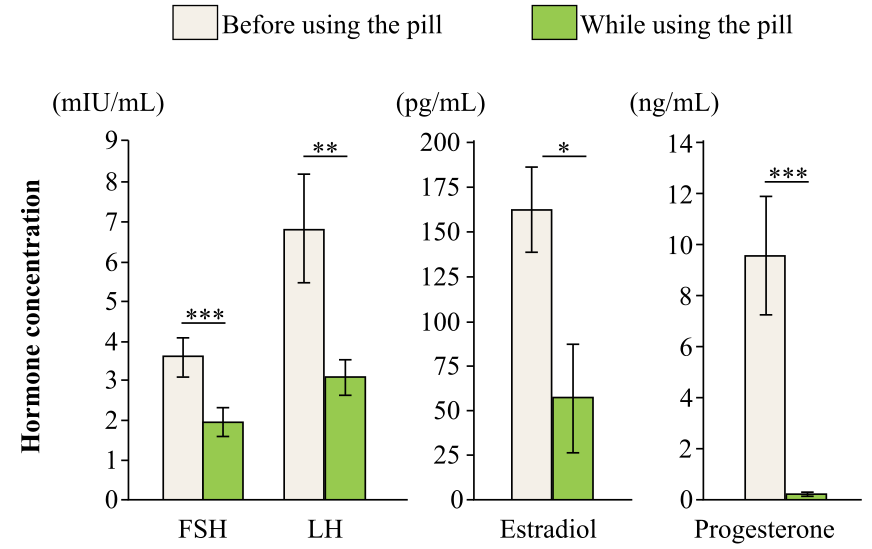
To analyze:
The pill’s effects on the normal hormonal function in the body in each of the following:
(a) Maturation of a follicle
(b) Thickening of the uterine lining during the follicular phase
(c) Probability of ovulation
(d) Volume of menstrual fluid
Introduction:
The FSH (follicle-stimulating hormone) is secreted by the anterior pituitary and regulates the pubertal maturation, growth, and development. It works along with LH (luteinizing hormone) in the reproductive system. The pill’s mechanism was confirmed by the scientists by measuring the plasma hormone levels before and after the use of the pill. Given below is a graph representing the different levels of progesterone at different pill concentrations. Single asterisk (*) signifies P < 0.05, double asterisks (&) signify P **lt; 0.01, and triple asterisks (&*) signify P **lt; 0.001.

Want to see the full answer?
Check out a sample textbook solution
Chapter 47 Solutions
Biological Science (7th Edition)
- Figure 43.17 Which of the following statements about the menstrual cycle is false? Progesterone levels rise during the luteal phase of the ovarian cycle and the secretory phase of the uterine cycle. Menstruation occurs just after LH and FSH levels peak. Menstruation occurs after progesterone levels drop. Estrogen levels rise before ovulation, while progesterone levels rise after.arrow_forwardDescribe the function of each of the following hormones in the uterine and ovarian cycles: GnRH, FSH, LH, estrogens, progesterone, and inhibin.arrow_forwardSelect the FALSE statement/s: A) The functional layer of the endometrium sloughs off when estrogen levels are at their lowest but progesterone levels at their highest. 1 OB) Every month, the 20 secondary follicles release 20 ova. OC) XX genotypic female exposed to high levels of androgen in utero will develop male-like exfernal genitalia OD) Both A and B OE) Both B and Carrow_forward
- Hight levels of progesterone promote:a). Development of the follicle b). Re-growth of the endometrium and mensesc). Thickening, vascularization and glandularization of the endometrium d). Development of the corpus luteume). GnRH pulse frequency to peakarrow_forwardDuring the menstrual cycle, the degradation of the corpus luteum causes what? A) The decrease of progesterone levels and the thickening of the endometrium. B) The decrease of estrogen levels and increase of progesterone levels. C) The decrease of estrogen levels and the thickening of the endometrium. D) the decrease of progesterone levels and menses(period)arrow_forwardWhich of the following causes bleeding (menstruation) during the menstrual cycle? a) Reduced release of progesterone from the ovaries b) Increased release of progesterone leading to blood clots c) Increased release of estrogen (estradiol) from the ovaries that simulates the uterine muscles to contract d) Reduced release of oxytocin which causes the uterine muscles to relaxarrow_forward
- Which of the following processes takes place simultaneously during the menstrual cycle? a) High LH levels and ovulation b) Reconstruction of the corpus luteum and increased release of progesterone from the ovaries c) Maximum LH release and menstruation (bleeding) d) Early follicular development and uterine lining e) Ovulation and menstruationarrow_forwardDescribe three physiologic functions that suppress ovulation when “the pill” is used as a method of contraception.arrow_forwardGive reason for the following :(a) The first half of the menstrual cycle is called follicular phase as well as proliferative phase.(b) The second half of the menstrual cycle is called luteal phase as well as secretory phase.arrow_forward
- Select the FALSE statement/s: During oogenesis OA) The 20 primary follicles produce the estrogens O B) The 20 secondary follicles undergo ovulation to release eggs O C) There are more primordial follicles than primary follicles at puberty OD) Both A and B OE) Both B and Carrow_forward1a) State the organ of origin of the following hormones and the function for: GnRH, FSH, LH, Estrogen, and Progesterone. 1b) The menstrual cycle contains both positive and negative feedback loops. Explain how. Please frame your answer using the “monitor -> control centre -> effector” scheme.arrow_forwardGross Anatomy of the Human Male Reproductive System a) List the two main functions of the testis. b) Why are the testes located in the scrotum rather than inside the ventral body cavity? c) An enlarged prostate is associated with a number of disorders, including prostatitis and prostate cancer. Describe the diagnostic exam used to detect an enlarged prostate.arrow_forward
 Human Physiology: From Cells to Systems (MindTap ...BiologyISBN:9781285866932Author:Lauralee SherwoodPublisher:Cengage Learning
Human Physiology: From Cells to Systems (MindTap ...BiologyISBN:9781285866932Author:Lauralee SherwoodPublisher:Cengage Learning Biology 2eBiologyISBN:9781947172517Author:Matthew Douglas, Jung Choi, Mary Ann ClarkPublisher:OpenStax
Biology 2eBiologyISBN:9781947172517Author:Matthew Douglas, Jung Choi, Mary Ann ClarkPublisher:OpenStax Biology (MindTap Course List)BiologyISBN:9781337392938Author:Eldra Solomon, Charles Martin, Diana W. Martin, Linda R. BergPublisher:Cengage Learning
Biology (MindTap Course List)BiologyISBN:9781337392938Author:Eldra Solomon, Charles Martin, Diana W. Martin, Linda R. BergPublisher:Cengage Learning



